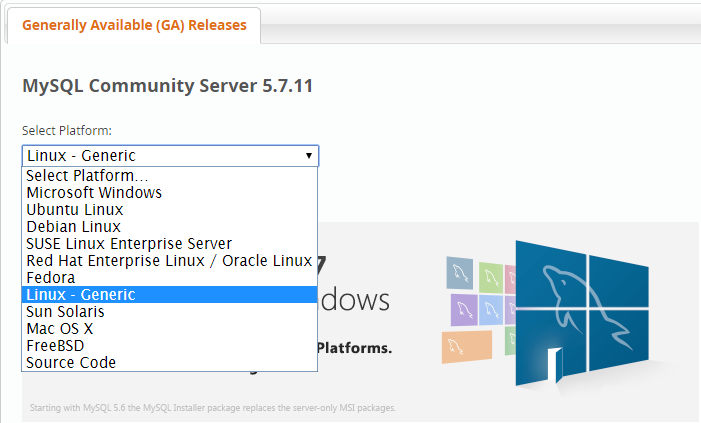MySQL有三个版本:二进制,源码包,RPM。
下面讲讲二进制包的安装过程
下载地址:
http://dev.mysql.com/downloads/mysql/

选择Linux-Generic
我这里选择的是mysql-5.6.28-linux-glibc2.5-x86_64.tar.gz
解压后,里面有个文件INSTALL-BINARY,其实给出了二进制包的部署过程
shell> groupadd mysql shell> useradd -r -g mysql -s /bin/false mysql shell> cd /usr/local shell> tar zxvf /path/to/mysql-VERSION-OS.tar.gz shell> ln -s full-path-to-mysql-VERSION-OS mysql shell> cd mysql shell> chown -R mysql . shell> chgrp -R mysql . shell> scripts/mysql_install_db --user=mysql shell> chown -R root . shell> chown -R mysql data shell> bin/mysqld_safe --user=mysql & # Next command is optional shell> cp support-files/mysql.server /etc/init.d/mysql.server
相对于实际生产环境的部署,上面在初始化数据库的过程中少了一步-即指定配置文件,如果配置文件确认了,数据目录,日志目录都确认了,MySQL二进制版本的部署还是相当容易的一件事情。
下面写了一个脚本,基于后面提供的配置文件,执行格式如下:
sh 4.sh /root/mysql-5.6.28-linux-glibc2.5-x86_64.tar.gz /mysql3306 3306
其中 4.sh是脚本,/root/mysql-5.6.28-linux-glibc2.5-x86_64.tar.gz是二进制包的绝对路径,/mysql3306是basedir,3306是需设置的端口,
利用该脚本,只需要预先定义好配置文件,就可进行MySQL数据库的快速部署以及一台服务器上多个实例的部署。
#!/bin/bash #需传入三个参数,第一个是mysql二进制压缩包的路径(绝对路径),譬如/root/mysql-5.6.28-linux-glibc2.5-x86_64.tar.gz, #第二个是mysql的basedir,即需要创建在哪个目录下,第三个是设置的端口号 filename=$1 basedir=$2 port=$3 groupadd mysql useradd -r -g mysql -s /bin/false mysql cd /usr/local tar zxvf $filename #file是获取mysql二进制包的名称,譬如mysql-5.6.28-linux-glibc2.5-x86_64.tar.gz #dir是mysql压缩包的路径,不含包名本身,譬如/root,因为后续的配置文件my.cnf也是放到这个路径下 file=`basename $filename` dir=`dirname $filename` #获取解压后的名字,即mysql-5.6.28-linux-glibc2.5-x86_64 after_tar_file=${file:0:-7} #将二进制包改名为 mysql+端口号,这样也便于后续的区分 mv $after_tar_file mysql"$port" cd mysql"$port" #将原始的配置文件(需和mysql压缩包放到同层目录下,在本例中是/root/my.cnf)copy到解压并改名后的mysql二进制目录下,修改为my+端口号.cnf cp $dir/my.cnf ./my"$port".cnf user_cnf=my"$port".cnf #下面主要是将原始配置文件中的路径修改为自己设定的路径,即传入的第二个参数 #整个的挑战在于传入的路径带有"/",在sed替换时会有问题,所有用了一个取巧的思路,即先将"/"替换为"|",进行sed替换,然后再将文件中的"|"修改回"/" basedir_new=${basedir///|} sed -i "s//project/class2/$basedir_new/g" $user_cnf sed -i "s/|///g" $user_cnf #设置server_id,取当前的秒值 server_id=`date +%s` sed -i /^server_id/s/.*/server_id="$server_id"/ $user_cnf #设置端口号 sed -i /^port/s/.*/port="$port"/ $user_cnf #创建必要的目录并修改权限 mkdir -p "$basedir"/mysql/{run,data,share,log,tmp} chown -R mysql $basedir chgrp -R mysql $basedir #下面这个是非必要的,具体看后面的总结 cp share/english/errmsg.sys "$basedir"/mysql/share/ #初始化时--force也是非必要的,具体可见后面的总结 scripts/mysql_install_db --user=mysql --defaults-file="$user_cnf" --force bin/mysqld_safe --defaults-file="$user_cnf" --user=mysql &
下面给出了配置文件的一个参考,大家可根据实际情况进行相应的修改
[mysqld_safe] pid-file=/project/class2/mysql/run/mysqld.pid [mysql] port=3306 prompt=\u@\d \r:\m:\s> default-character-set=utf8 no-auto-rehash [client] port=3306 socket=/project/class2/mysql/run/mysql.sock [mysqld] #dir basedir=/project/class2/mysql datadir=/project/class2/mysql/data tmpdir=/tmp lc_messages_dir=/project/class2/mysql/share log-error=/project/class2/mysql/log/alert.log slow_query_log_file=/project/class2/mysql/log/slow.log general_log_file=/project/class2/mysql/log/general.log socket=/project/class2/mysql/run/mysql.sock #innodb innodb_data_home_dir=/project/class2/mysql/data innodb_log_group_home_dir=/project/class2/mysql/data innodb_data_file_path=ibdata1:2G;ibdata2:16M:autoextend innodb_buffer_pool_size=10G innodb_buffer_pool_instances=4 innodb_log_files_in_group=2 innodb_log_file_size=1G innodb_log_buffer_size=200M innodb_flush_log_at_trx_commit=1 innodb_additional_mem_pool_size=20M innodb_max_dirty_pages_pct=60 innodb_io_capacity=1000 innodb_thread_concurrency=16 innodb_read_io_threads=8 innodb_write_io_threads=8 innodb_open_files=60000 innodb_file_format=Barracuda innodb_file_per_table=1 innodb_flush_method=O_DIRECT innodb_change_buffering=inserts innodb_adaptive_flushing=1 innodb_old_blocks_time=1000 innodb_stats_on_metadata=0 innodb_read_ahead=0 innodb_use_native_aio=0 innodb_lock_wait_timeout=5 innodb_rollback_on_timeout=0 innodb_purge_threads=1 innodb_strict_mode=1 transaction-isolation=READ-COMMITTED #myisam key_buffer=64M myisam_sort_buffer_size=64M concurrent_insert=2 delayed_insert_timeout=300 #replication master-info-file=/project/class2/mysql/log/master.info relay-log=/project/class2/mysql/log/relaylog relay_log_info_file=/project/class2/mysql/log/relay-log.info relay-log-index=/project/class2/mysql/log/mysqld-relay-bin.index slave_load_tmpdir=/project/class2/mysql/tmp slave_type_conversions="ALL_NON_LOSSY" slave_net_timeout=4 skip-slave-start sync_master_info=1000 sync_relay_log_info=1000 #binlog log-bin=/project/class2/mysql/log/mysql-bin server_id=2552763370 binlog_cache_size=32K max_binlog_cache_size=2G max_binlog_size=500M binlog-format=ROW sync_binlog=1000 log-slave-updates=1 expire_logs_days=0 #server default-storage-engine=INNODB character-set-server=utf8 lower_case_table_names=1 skip-external-locking open_files_limit=65536 safe-user-create local-infile=1 #sqlmod="STRICT_ALL_TABLES,NO_ZERO_IN_DATE,NO_ZERO_DATE" log_slow_admin_statements=1 log_warnings=1 long_query_time=1 slow_query_log=1 general_log=0 query_cache_type=0 query_cache_limit=1M query_cache_min_res_unit=1K table_definition_cache=65536 thread_stack=512K thread_cache_size=256 read_rnd_buffer_size=128K sort_buffer_size=256K join_buffer_size=128K read_buffer_size=128K port=3306 skip-name-resolve skip-ssl max_connections=4500 max_user_connections=4000 max_connect_errors=65536 max_allowed_packet=128M connect_timeout=8 net_read_timeout=30 net_write_timeout=60 back_log=1024
总结:
在初始化的过程中,如果报以下错误:
FATAL ERROR: Neither host 'keepalived02' nor 'localhost' could be looked up with /mysql3306/mysql/bin/resolveip Please configure the 'hostname' command to return a correct hostname. If you want to solve this at a later stage, restart this script with the --force option
但是在bash终端上执行hostname命令又确实有值返回,可加--force参数,如下所示:
scripts/mysql_install_db --user=mysql --defaults-file="$user_cnf" --force
如果报以下错误:
[ERROR] Can't find messagefile '/mysql3306/mysql/share/errmsg.sys'
可将二进制版本中share/english/errmsg.sys文件COPY到/mysql3306/mysql/share/下。
--------------------------------------
后续:这两个错误的原因都是因为basedir修改了,它默认是在二进制包中查找的。